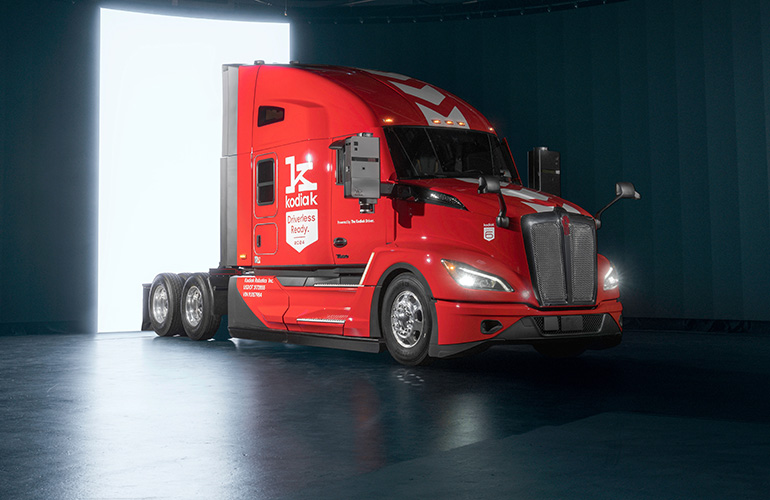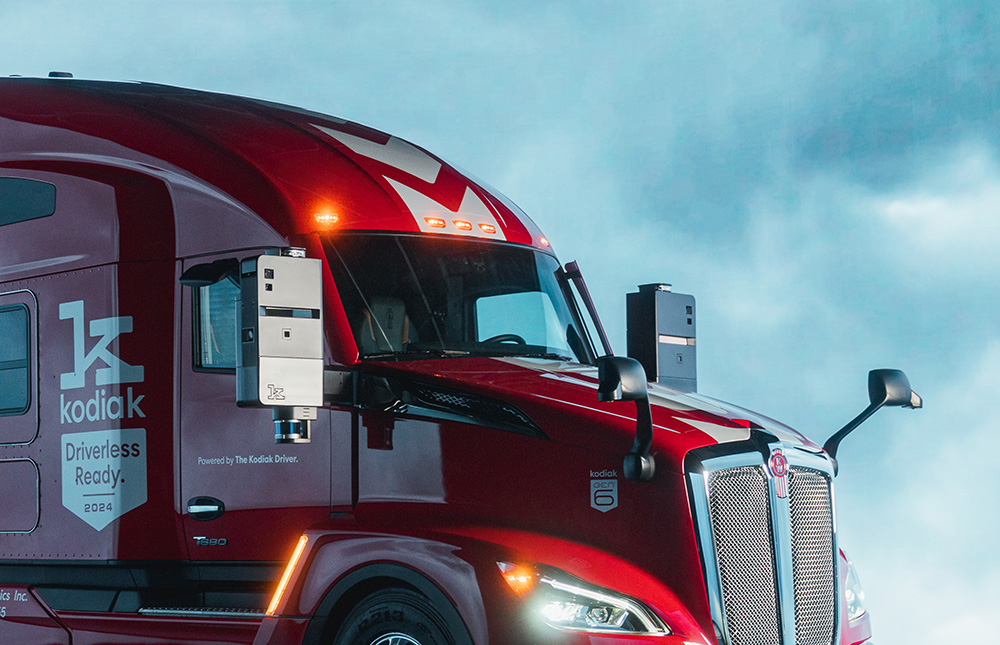|
Listen to this article  |

Kodiak’s sixth-generation driverless truck. | Source: Kodiak Robotics
Kodiak Robotics Inc. introduced its sixth-generation, driverless-ready semi truck at CES in Las Vegas this week. The company said its self-driving truck is designed for scaled deployment and builds on five years of real-world testing. This testing included 5,000 loads carried over more than 2.5 million miles.
The Mountain View, Calif.-based company said it will use the new truck for its own driverless operations on roadways between Dallas and Houston this year.
“Over the course of 2.5 million miles, we’ve successfully demonstrated that our self-driving trucks can withstand the harsh environment of long-haul trucking from both a platform integrity and a software perspective,” said Don Burnette, founder and CEO of Kodiak, in a release.
“This truck fundamentally demonstrates that we’ve done the work necessary to safely handle driverless operations,” he added. “While we continue to work with leading truck manufacturers, the technology we developed is deployment-ready, uncoupled from OEM timelines and truck manufacturer-agnostic, which allows us to move fast while keeping safety at the forefront.”
Kodiak said the latest edition of its autonomous semi-trucks has all the necessary redundant safety-critical hardware. These include braking, steering, and sensors, as well as the software required for driverless operations at scale.
Redundancy is the key to safety, says Kodiak
Kodiak noted that its latest autonomous semi-truck includes redundancy across all safety-critical functions. These include a redundant braking system, redundant steering, and redundant power.
While traditional semi-trailer trucks have redundant braking systems, Kodiak said it wanted to take this further. Its trucks’ pneumatic braking systems consist of three individual brake actuators.
All three actuators are simultaneously controlled by Kodiak’s system. This means that if any of them fail, the backup systems can prevent loss of control and bring the truck to a safe stop.
The company has also equipped its trucks with a dual-redundant steering system that includes two redundant ZF actuators controlled by Kodiak’s safety system.
Based on the company‘s safety analysis, if the primary steering actuator experiences any type of failure, then the steering system switches to the secondary actuator. This allows the system to maintain full control and move the vehicle into a safe state without compromising the vehicle dynamics.
The trucks have a redundant power system that powers the computers, sensors, actuators, and all other electrical systems. Kodiak said its power system is split into two fully isolated subsystems. These subsystems ensure that all safety systems can still perform a safe “fallback” should either fail.
In addition, Kodiak asserted that all of its trucks, not just the most recent generation, are equipped with its custom-designed Actuation Control Engine (ACE). The ACE system is a high-integrity safety computer responsible for ensuring that the Kodiak Driver can guide the truck to a fallback out of the flow of traffic should a critical system failure occur.
Finally, the truck includes a redundant LTE communications links, allowing the truck to establish reliable communications with Kodiak’s redundant command centers in Lancaster, Texas, and Mountain View, Calif.

Kodiak’s latest generation of trucks features upgraded SensorPods and more. | Source: Kodiak Robotics
Inside the sixth-generation truck
Like its previous trucks, Kodiak’s sixth-generation vehicle features its Kodiak Driver, a vehicle-agnostic self-driving system and driverless-ready hardware platform. The vehicle-agnostic aspects of the driver will come in handy because the company plans to roll out its sixth-generation platform to multiple vehicle types.
Kodiak claimed that its latest trucks feature twice the GPU processor cores, 1.6 times greater processing speed, three times more memory, and 2.75 times greater bandwidth to run software processes than its first-generation truck.
This latest generation of trucks also features upgrades to Kodiak’s proprietary SensorPods, which house the sensors and are pre-calibrated and pre-built for fast and easy repairs. Kodiak improved its SensorPods with two higher-resolution lidars, which are now automotive-grade. It also has two additional side radar sensors to improve long-range detection.
In total, Kodiak equipped its trucks with 12 cameras, four lidar sensors, and six radar sensors. To process this increased sensor data, the self-driving truck maker relies on NVIDIA GPUs.
The company also added top-mounted, extra-bright hazard lights to its SensorPods. Kodiak designed these lights to comply with the autonomous trucking industry’s application for an exemption to Federal Motor Vehicle Safety Regulation 392.22. This regulation requires traditional truck drivers to place warning devices on a roadway after a breakdown.
Since driverless trucks won’t be able to place road flares or other devices along the roadway, Kodiak said these lights will be used to alert other drivers to the presence of a truck on the side of the road, pending Federal Motor Carrier Safety Administration approval.
Kodiak also equipped its trucks with microphones, so that its trucks can detect and identify the presence of emergency vehicles and other suspicious sounds that could represent a hazard.
Kodiak’s sixth-generation truck follows the company’s partnership with Pilot to open a truckport for launching and landing autonomous trucks. It has also teamed up with Loadsmith, C.R. England and Tyson, Forward and more.
Kodiak plans to continue improving its self-driving trucks. For instance, it plans to integrate an Ambarella CV3-AD AI domain control system on chip (SoC).
Credit: Source link


Comments are closed.